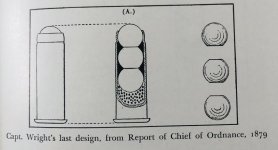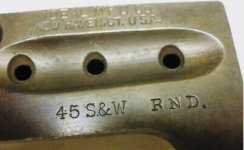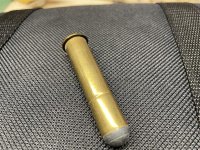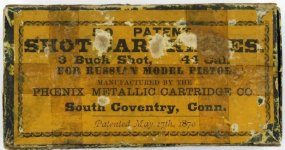During the Military pistol trials of the late 1870's a new cartridge design was fabricated by the Frankford Arsenal initially for the Colt and Springfield rifle titled the "Multi-Ball" cartridge. See photo 1
I'm abbreviating the records but the results were well excepted by the Cavalry. This new design was heavily tested at various ranges and clearly recorded. Example: At 25 yards 10 rounds equaling 30 bullets fired from the Colt pistol patterned inside a 12" circle. The recoil increased from 21 lbs to 34 Lbs.
Imagine shooting at a moving target from horseback with a pistol that now discharged 3 bullets with every shot fired!
The round was modified to chamber yet again in both the Colt and Schofield revolvers and initial production was 9000 rounds from the Frankford Arsenal in 1879. In 1880 only 300 rounds were issued and after 1880 the records are silent. It is believed that this was only a test round that was never adapted.
I totally disagree. Each post was issued reloading kits and tools that included a 45 cal Gang ball mold for both the 45 pistol and 45/70 Springfield rifle that is also assumed to be for gallery loading. That is ridiculous if you think about it.
Again, the Cavalry liked the round and are documented as complaining to the Frankford Arsenal for not producing more. My research proves that hand loading became the norm in the 1880-1882 time frame. That clearly included round ball loads.
Doesn't take rocket science to see the clear benefit of an 18 shooter Schofield revolver from horseback against a moving target at basically any distance up to a realistic 75 yards.
Fast forward to 4am this morning. See photos
This is an Ideal 45 Schofield gang mold Special order for that exact same 3 ball cartridge. Unfortunately, someone wanted it more than I did. This should be a wake up call for historians and Schofield collectors. It was in fact an 18 shooter quite often during the Indian Wars.
Murph
I'm abbreviating the records but the results were well excepted by the Cavalry. This new design was heavily tested at various ranges and clearly recorded. Example: At 25 yards 10 rounds equaling 30 bullets fired from the Colt pistol patterned inside a 12" circle. The recoil increased from 21 lbs to 34 Lbs.
Imagine shooting at a moving target from horseback with a pistol that now discharged 3 bullets with every shot fired!
The round was modified to chamber yet again in both the Colt and Schofield revolvers and initial production was 9000 rounds from the Frankford Arsenal in 1879. In 1880 only 300 rounds were issued and after 1880 the records are silent. It is believed that this was only a test round that was never adapted.
I totally disagree. Each post was issued reloading kits and tools that included a 45 cal Gang ball mold for both the 45 pistol and 45/70 Springfield rifle that is also assumed to be for gallery loading. That is ridiculous if you think about it.
Again, the Cavalry liked the round and are documented as complaining to the Frankford Arsenal for not producing more. My research proves that hand loading became the norm in the 1880-1882 time frame. That clearly included round ball loads.
Doesn't take rocket science to see the clear benefit of an 18 shooter Schofield revolver from horseback against a moving target at basically any distance up to a realistic 75 yards.
Fast forward to 4am this morning. See photos
This is an Ideal 45 Schofield gang mold Special order for that exact same 3 ball cartridge. Unfortunately, someone wanted it more than I did. This should be a wake up call for historians and Schofield collectors. It was in fact an 18 shooter quite often during the Indian Wars.
Murph










